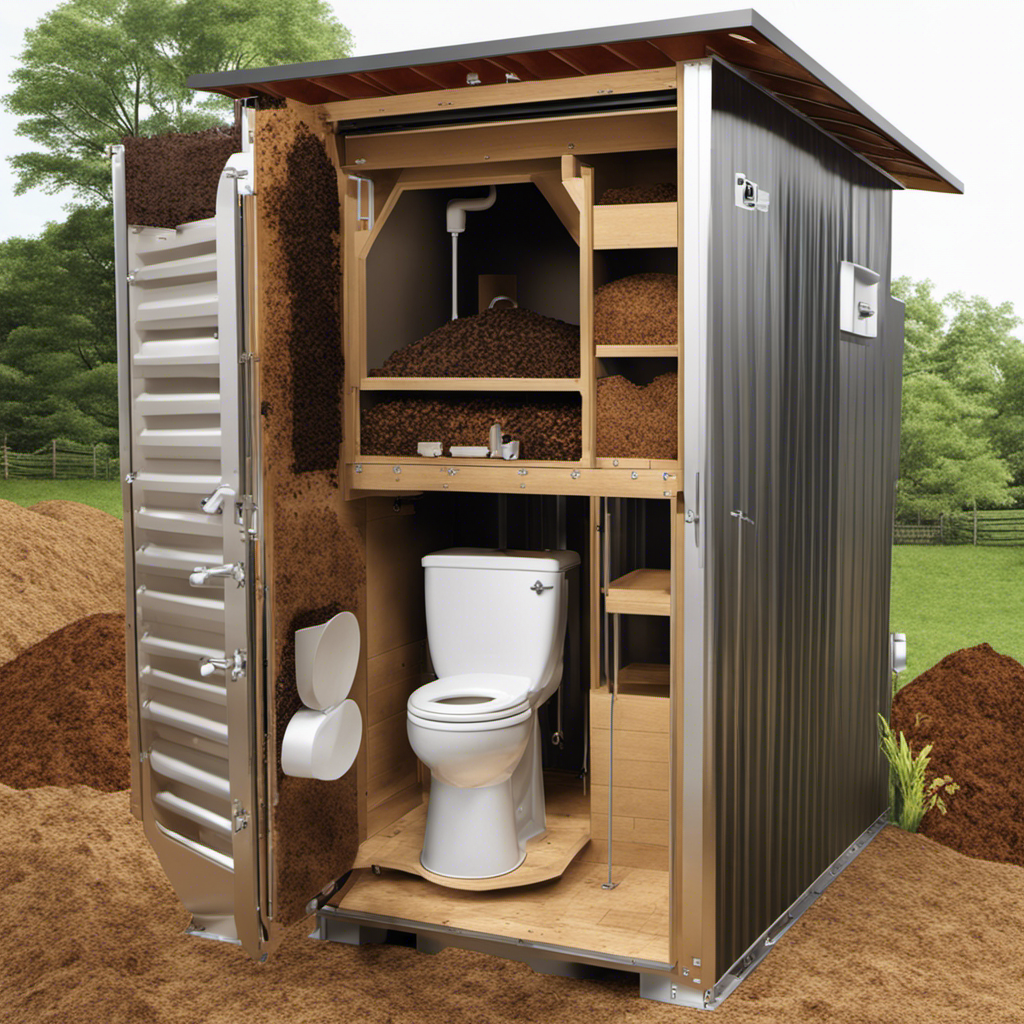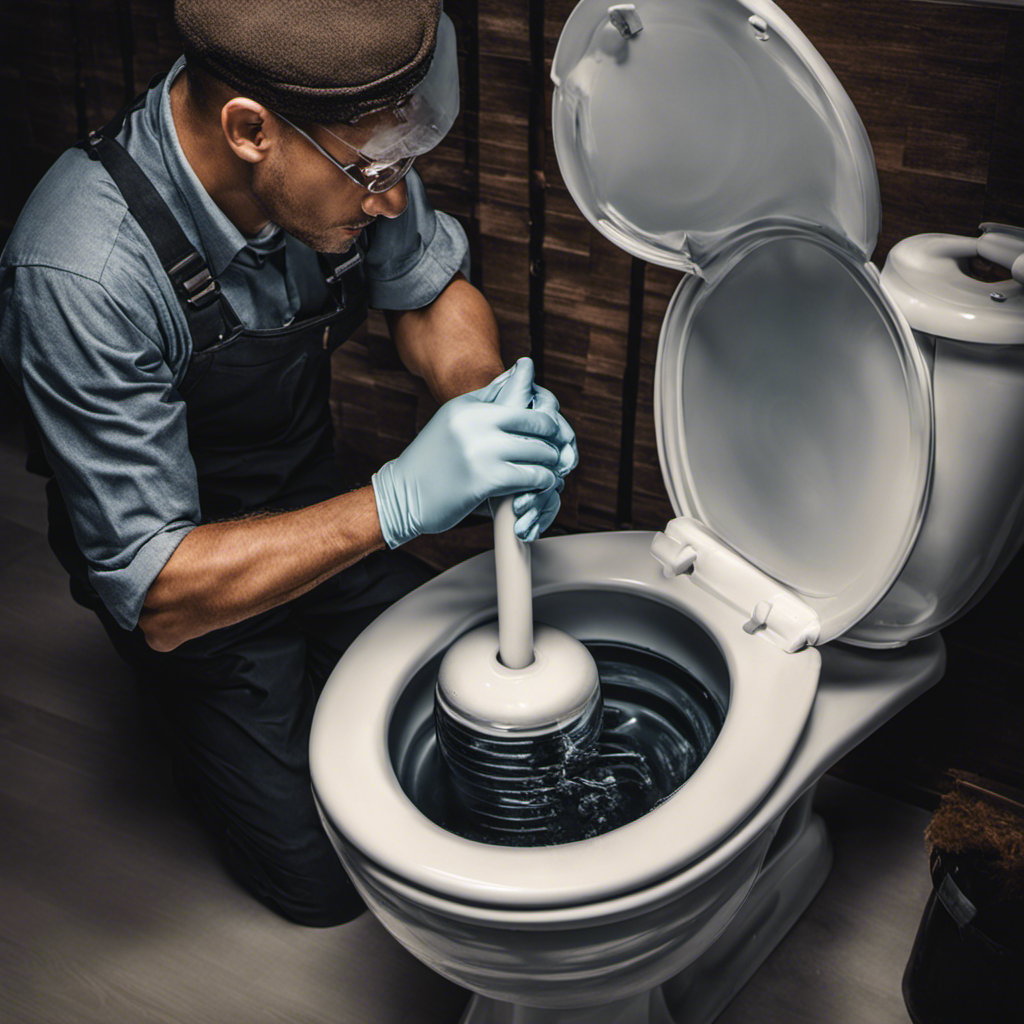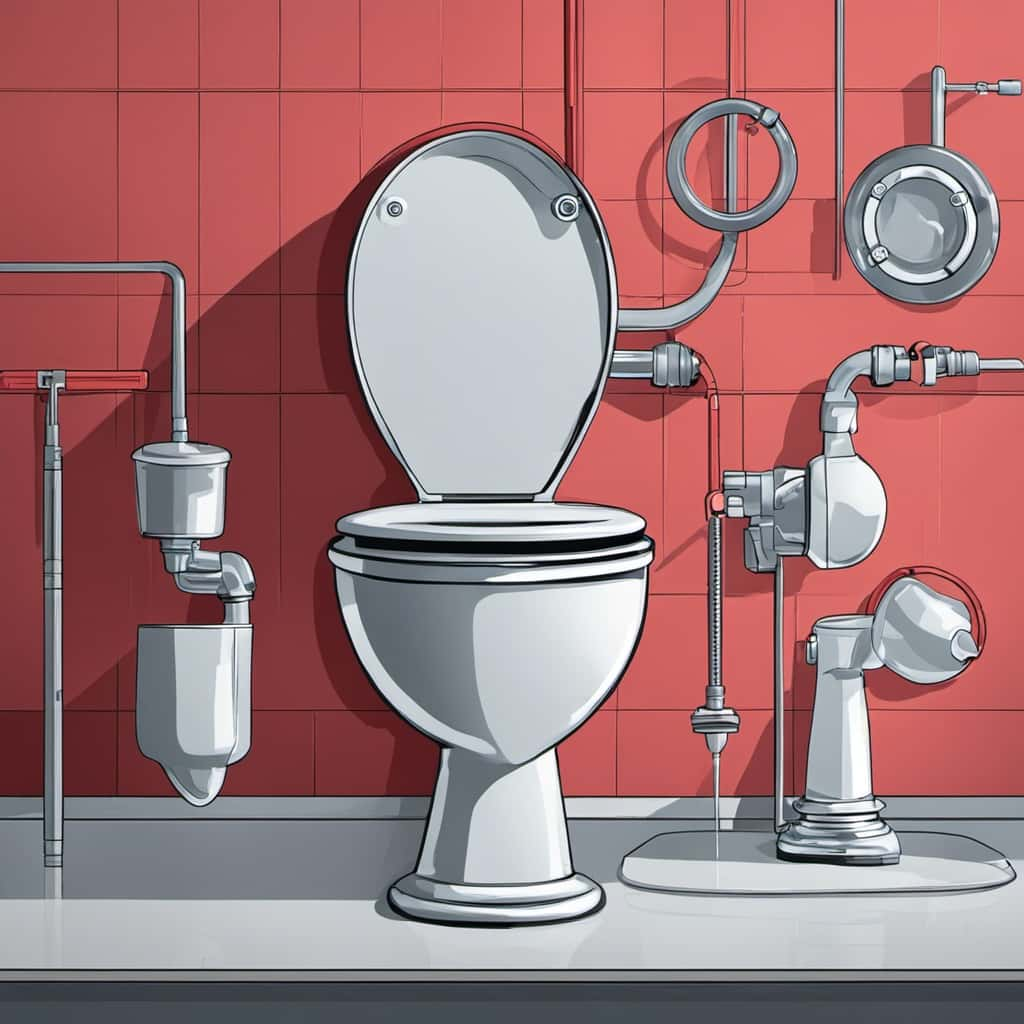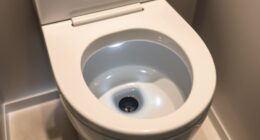I’ve always been curious about how toilets work. It’s fascinating to think about the intricate mechanisms that allow us to flush away waste with just the push of a lever.
In this article, I will take you on a technical journey, explaining the inner workings of a toilet in precise detail.
From the water supply and flush mechanism to the role of the flapper valve and the trap and drain system, we will explore every aspect of how a toilet functions.
So, let’s dive in and uncover the truth behind this essential everyday appliance.
Key Takeaways
- Understanding the different parts of a toilet, such as the tank, fill valve, flush valve, and flapper, helps in comprehending how a toilet functions.
- The water supply is connected to the toilet tank, and the float valve regulates the water level in the tank. The flush lever lifts the chain connected to the flapper valve, allowing water to rush into the bowl and creating a siphoning effect to remove waste.
- The flapper valve is responsible for controlling the release of water from the tank to the bowl and creating a seal to prevent continuous flow. Regular maintenance, cleaning, and replacement of the flapper valve are important for its proper functioning.
- Common issues with the flapper valve include leaks, improper sealing, weak flushes, and failure to close properly. Troubleshooting steps are available for each of these issues.
Parts of a Toilet
To understand how a toilet works, you should know about its main parts.
The toilet tank is one of the key components. It is usually located behind the toilet bowl and is responsible for holding the water that is used for flushing.
Inside the tank, you will find a fill valve, a flush valve, and a flapper. The fill valve regulates the water level in the tank, ensuring that it is always at the right height.
The flush valve is a mechanism that controls the release of water from the tank into the toilet bowl when you flush. The flapper is a rubber seal that covers the flush valve and prevents water from leaking out of the tank.
Understanding these parts will give you a better understanding of how a toilet functions.
Water Supply and Flush Mechanism
You’ll need to understand how the water supply and flush mechanism work in order to operate a toilet effectively.
The water supply is connected to the toilet tank, which holds the water until you flush. A float valve controls the water level in the tank, shutting off the supply when it reaches the desired level.
When you push the flush lever, it lifts a chain connected to the flapper valve at the bottom of the tank. The flapper valve opens, allowing water to rush from the tank into the toilet bowl.
This sudden rush of water creates a siphoning effect, which pulls waste and wastewater from the bowl into the drainpipe. The water continues to flow until the tank is empty, and the flapper valve closes, stopping the flow.
Understanding the water supply and flush mechanism is crucial for proper toilet operation.
Understanding the Flapper Valve
The flapper valve is a crucial component of a toilet’s flushing mechanism. It is responsible for controlling the release of water from the tank into the bowl. Its primary function is to create a seal that prevents water from continuously flowing into the bowl.
However, over time, flapper valves can develop issues such as leaks, sticking, or improper sealing. These issues can lead to water wastage and inefficient flushing. Regular maintenance is essential to ensure the proper functioning of the toilet and prevent potential water damage.
Cleaning and replacing the flapper valve when necessary are important parts of this maintenance routine. By doing so, you can prevent leaks and ensure that the toilet flushes efficiently. Taking care of the flapper valve will help save water and keep your toilet in good working condition.
Flapper Valve Function
When the toilet is flushed, the flapper valve lifts up, allowing water to flow from the tank into the bowl. The flapper valve is a crucial component of the toilet’s flushing mechanism. It is responsible for controlling the water flow and ensuring a proper flush. Understanding the function of the flapper valve is essential for troubleshooting and replacement purposes.
Here are two important aspects of the flapper valve function:
-
Water Seal: When the toilet is not in use, the flapper valve creates a water seal between the tank and the bowl, preventing any water from entering the bowl.
-
Flush Activation: When the toilet handle is pressed, it lifts the flapper valve, which releases the water from the tank into the bowl, creating a powerful flush.
Common Flapper Valve Issues
To troubleshoot common flapper valve issues, start by checking for leaks or improper sealing. The flapper valve is a crucial component of a toilet’s flushing mechanism, and any malfunction can lead to water wastage or a weak flush. Here are some common issues you may encounter with a flapper valve and how to troubleshoot them:
| Issue | Possible Causes | Troubleshooting Steps |
|---|---|---|
| Leaking flapper | Worn-out flapper or chain | Replace flapper or adjust chain |
| Flapper not sealing | Debris or mineral buildup | Clean flapper or replace if damaged |
| Weak flush | Insufficient water in tank | Check water level and adjust |
| Flapper not closing | Chain too loose or tangled | Adjust chain length or untangle |
If troubleshooting doesn’t resolve the issue, flapper valve replacement may be necessary. It’s important to choose a flapper valve that is compatible with your toilet model for optimal performance.
Flapper Valve Maintenance
Regular flapper valve maintenance is essential to prevent leaks and ensure proper function. Neglecting this crucial step can lead to water wastage and potential damage to your toilet. Here are some important tips to keep your flapper valve in top shape:
- Check for wear and tear: Inspect the flapper valve regularly for any signs of deterioration, such as cracks or warping.
- Clean the valve and seat: Remove any debris or mineral deposits that may interfere with the flapper’s sealing ability.
- Adjust the chain length: Ensure that the chain connecting the flapper valve to the toilet handle has the right amount of slack to allow for proper flushing.
If despite regular maintenance, your flapper valve continues to cause issues, it may be time for a replacement. Troubleshooting flapper valve problems early on can save you from more significant repairs down the line.
Now, let’s explore the differences between gravity and pressure-assisted toilets.
Gravity Vs. Pressure-Assisted Toilets
If you’re considering a new toilet, you might want to know the difference between gravity and pressure-assisted toilets.
Gravity toilets rely solely on the force of gravity to flush waste down the drain. They have a larger, wider trapway that allows water and waste to flow smoothly.
On the other hand, pressure-assisted toilets use compressed air to create a powerful flush. They have a smaller, narrower trapway which increases the velocity of the water, resulting in a more forceful flush. Pressure-assisted toilets are often used in commercial settings where a strong flush is required.
The main advantage of gravity toilets is their quiet operation, while pressure-assisted toilets offer a more efficient and effective flush.
Now that we understand the difference between the two, let’s delve into the role of the fill valve.
The Role of the Fill Valve
The fill valve is a crucial component in the functioning of a toilet. Its main function is to regulate the water supply to the toilet tank, ensuring that it is filled to the appropriate level after each flush.
The fill valve works in conjunction with the water supply mechanism, which typically consists of a water line and a shut-off valve.
Proper installation of the fill valve is essential to prevent water leakage, maintain optimal water pressure, and ensure the efficient operation of the toilet.
Fill Valve Function
To understand how a toilet works, you need to know that one of its key components is the fill valve. The fill valve is responsible for regulating the water flow into the toilet tank after each flush. It ensures that the tank refills to the appropriate level so that it is ready for the next use.
To properly maintain the fill valve, regular maintenance is essential. This includes cleaning the valve and checking for any signs of wear or damage. If you notice any issues with the fill valve, troubleshooting may be necessary. Here are some common troubleshooting steps for a fill valve:
- Check for clogs or debris blocking the valve’s inlet
- Adjust the float arm to ensure proper water level
- Inspect the valve for leaks or worn-out parts
- Replace the fill valve if necessary
Water Supply Mechanism
Understanding how your toilet’s water supply mechanism functions is important for proper maintenance and troubleshooting.
The water supply mechanism in a toilet consists of the toilet tank and the toilet bowl. When you flush the toilet, the water from the tank is released into the bowl to remove waste.
The water supply mechanism is controlled by a fill valve, which allows water to flow into the tank and fill it up after each flush. The fill valve is connected to the water supply line, which provides a constant flow of water to the tank.
Once the tank is filled, the water is released into the bowl through the flush valve, creating a strong force that effectively removes waste.
It is crucial to ensure that the water supply mechanism is functioning properly to avoid any issues with flushing and water flow. Regular maintenance and troubleshooting can help identify and fix any problems with the water supply mechanism.
Importance of Proper Installation
Proper installation of a toilet’s water supply mechanism is crucial to ensure its functionality and prevent any potential issues. When it comes to toilet efficiency, every component plays a vital role. Here are two key factors to consider for proper installation:
-
Water pressure regulation: Ensure that the water pressure is appropriate for the toilet’s specific requirements. High water pressure can cause damage to the internal mechanisms, while low water pressure may result in inefficient flushing.
-
Leak prevention: Properly install the water supply line and make sure all connections are tight and secure. Any leaks can lead to wasted water and potential damage to the surrounding area.
By following these installation guidelines, you can optimize the efficiency of your toilet and avoid costly repairs down the line.
Now, let’s delve into how the trap and drain system works.
How the Trap and Drain System Works
The trap and drain system in a toilet works by preventing sewer gases from entering the bathroom. It consists of a trap mechanism and a drain pipe that work together to ensure proper waste disposal. The trap mechanism is a curved section of the toilet’s plumbing that holds a small amount of water, creating a seal that prevents sewer gases from escaping into the bathroom. The drain pipe, connected to the trap, carries waste materials away from the toilet and into the sewer system. This system ensures that foul odors and harmful gases are trapped and safely removed, maintaining a healthy and pleasant environment in the bathroom.
| Trap Mechanism | Drain Pipe |
|---|---|
| Curved section of plumbing | Carries waste materials |
| Holds water to create a seal | Removes waste from toilet |
| Prevents sewer gases from escaping | Connects to sewer system |
| Ensures a healthy and pleasant environment | Disposes waste properly |
Frequently Asked Questions
How Often Should I Replace the Flapper Valve in My Toilet?
I replace the flapper valve in my toilet tank every 2-3 years. It’s important to keep an eye on it as a worn-out valve can cause water leakage between the tank and the toilet bowl.
Is It Possible to Convert a Gravity Toilet Into a Pressure-Assisted Toilet?
Yes, it is possible to convert a gravity toilet into a pressure-assisted toilet. The process involves installing a pressure-assist unit in the tank. Advantages include improved flushing power, but disadvantages include higher cost and noise levels.
What Is the Purpose of the Fill Valve in a Toilet?
The fill valve in a toilet is responsible for refilling the tank after each flush. It monitors the water level and controls the flow of water. Regular maintenance is crucial to prevent leaks and ensure proper functioning. Different types of fill valves are available, including ballcock and float valves.
Can a Clogged Trap and Drain System Cause a Toilet to Overflow?
Yes, a clogged trap and drain system can cause a toilet to overflow. If the water cannot flow through the drain system, it will back up into the toilet bowl. To prevent this, regular maintenance, such as flapper valve replacements and gravity toilet conversions, is necessary. Additionally, ensuring the fill valve is working properly and the toilet water supply is adequate is important.
How Do I Know if My Toilet’s Water Supply Is Working Properly?
To determine if my toilet’s water supply is functioning correctly, I check the toilet water pressure and water level. Proper water pressure ensures efficient flushing, while the water level should be at the appropriate height for optimal performance.
Conclusion
In conclusion, understanding how a toilet works is essential for maintaining its proper functioning. By examining its various parts, including the water supply, flush mechanism, flapper valve, and fill valve, we can grasp the intricacies of its operation.
Additionally, knowing the difference between gravity and pressure-assisted toilets can help in choosing the right option for specific needs.
Lastly, the trap and drain system play a crucial role in ensuring efficient waste removal. Contrary to popular belief, toilets do not simply ‘flush things away,’ but rather rely on a complex system to achieve this task.










